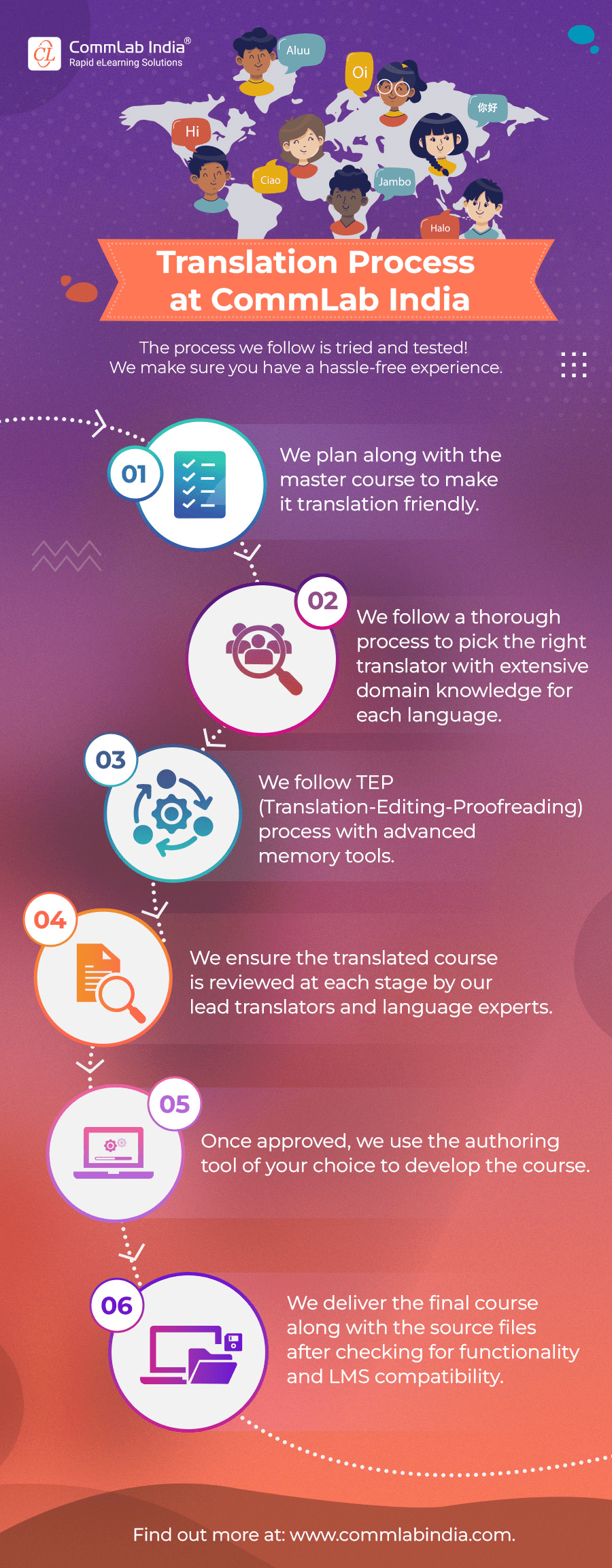How to Master eLearning Course Translations? 6 Step Process to Success [Infographic]
![How to Master eLearning Course Translations? 6 Step Process to Success [Infographic] How to Master eLearning Course Translations? 6 Step Process to Success [Infographic]](https://blog.commlabindia.com/hubfs/Imported_Blog_Media/translation-cost-of-elearning-1-1.jpg)
Imagine you've developed an outstanding eLearning course that resonates perfectly with your target audience. It's interactive, engaging, and packed with valuable content. Now, envision the opportunity to extend the reach of this valuable content to a global audience. How do you ensure the seamless transition of your eLearning masterpiece into different languages without compromising its effectiveness? eLearning translations is how!
In this blog, we will navigate through the essential 6-step eLearning course translation process, unlocking the key strategies to bridge language gaps and deliver impactful learning experiences worldwide.
What is eLearning Translation and Why do Organizations Need them?
eLearning translation involves adapting digital training content into different languages, making it accessible to diverse audiences. This process enhances global reach, promotes cultural inclusivity, and ensures effective knowledge transfer across language barriers.
The key benefits of eLearning translation include:
1. Global Accessibility: Reach a broader audience by offering courses in multiple languages.
2. Cultural Inclusivity: Tailor content to diverse cultural contexts, enhancing learner engagement.
3. Compliance with Regulations: Adhere to regional language requirements and compliance standards.
4. Enhanced Learning Experience: Improve understanding and retention for non-native language speakers.
5. Increased Market Penetration: Expand into international markets by breaking language barriers.
6. Cost-Efficiency: Optimize training investments by repurposing content for different language groups.
Here's why organizations need eLearning translations:
→ Download Now: A Practical Guide to Outsourcing eLearning Design & Development [eBook]
The Process of eLearning Translations
There is a lot that goes behind the translation of an online training course. If you have an in-house team of translators with the required expertise in eLearning translations, go ahead with the translation project. But if you lack an experienced in-house team, it is better to outsource the eLearning translation to a vendor. Here is an infographic that explains how you can successfully translate your eLearning courses by partnering with an eLearning vendor.
Summing Up
As you embark on the journey to make your eLearning course accessible to a global audience, the 6-step eLearning course translation process stands as the gateway to success. From ensuring cultural inclusivity to complying with regulations and optimizing cost-efficiency, the benefits are compelling. Now, take the next step and explore the world of eLearning translations with confidence.
Ready to unlock the potential of your eLearning content worldwide? Find the right eLearning outsourcing partner to guide you through the seamless translation process. Click the link below to discover the ideal partner for your global eLearning initiatives.
Editor’s note: This post was originally published in January ,2024 and has been updated for comprehensiveness.





![Is eLearning Development Slowing You Down? Switch to Rapid! [Infographic]](https://blog.commlabindia.com/hubfs/Imported_Blog_Media/switch-to-rapid-elearning-infographic1.jpg)

